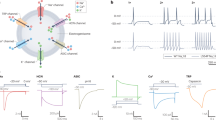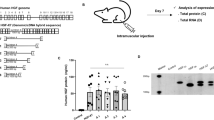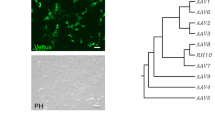Abstract
Gene transfer to the dorsal root ganglion using replication defective herpes simplex virus (HSV)-based vectors reduces pain-related behaviors in rodent models having inflammatory pain, neuropathic pain and pain caused by cancer in bone. HSV vectors engineered to produce inhibitory neurotransmitters, including the delta opioid agonist peptide enkephalin, the mu opioid agonist peptide endomorphin-2 and glutamic acid decarboxylase (GAD), to effect the release of gamma amino butyric acid (GABA) act to inhibit nociceptive neurotransmission at the first synapse between primary nociceptive and second-order neuron in the dorsal horn of the spinal cord. HSV vectors engineered to release anti-inflammatory peptides, including interleukin (IL)-4, IL-10 and the p55 soluble tumor necrosis factor α (TNFα) receptor reduce neuroimmune activation in the spinal dorsal horn. The path leading from preclinical animal studies to the ongoing phase 1 human trial of the enkephalin-producing vector in patients with pain from cancer, and plans for an efficacy trial with an opioid-producing vector in inflammatory pain and an efficacy trial with a GAD-producing vector in diabetic neuropathic pain are outlined.
This is a preview of subscription content, access via your institution
Access options
Subscribe to this journal
Receive 12 print issues and online access
$259.00 per year
only $21.58 per issue
Buy this article
- Purchase on Springer Link
- Instant access to full article PDF
Prices may be subject to local taxes which are calculated during checkout



Similar content being viewed by others
References
Mata M, Hao S, Fink DJ . Applications of gene therapy to the treatment of chronic pain. Curr Gene Ther 2008; 8: 42–48.
Wolfe D, Goins WF, Yamada M, Moriuchi S, Krisky DM, Oligino TJ et al. Engineering herpes simplex virus vectors for CNS applications. Exp Neurol 1999; 159: 34–46.
Glorioso JC, Fink DJ . Herpes vector-mediated gene transfer in treatment of diseases of the nervous system. Annu Rev Microbiol 2004; 58: 253–271.
Jasmin L, Rabkin SD, Granato A, Boudah A, Ohara PT . Analgesia and hyperalgesia from GABA-mediated modulation of the cerebral cortex. Nature 2003; 424: 316–320.
Kang W, Wilson MA, Bender MA, Glorioso JC, Wilson SP . Herpes virus-mediated preproenkephalin gene transfer to the amygdala is antinociceptive. Brain Res 1998; 792: 133–135.
Finegold AA, Mannes AJ, Iadarola MJ . A paracrine paradigm for in vivo gene therapy in the central nervous system: treatment of chronic pain. Hum Gene Ther 1999; 10: 1251–1257.
Ledeboer A, Jekich BM, Sloane EM, Mahoney JH, Langer SJ, Milligan ED et al. Intrathecal interleukin-10 gene therapy attenuates paclitaxel-induced mechanical allodynia and proinflammatory cytokine expression in dorsal root ganglia in rats. Brain Behav Immun 2007; 21: 686–698.
Milligan ED, Soderquist RG, Malone SM, Mahoney JH, Hughes TS, Langer SJ et al. Intrathecal polymer-based interleukin-10 gene delivery for neuropathic pain. Neuron Glia Biol 2006; 2: 293–308.
Meunier A, Latremoliere A, Dominguez E, Mauborgne A, Philippe S, Hamon M et al. Lentiviral-mediated targeted NF-kappaB blockade in dorsal spinal cord glia attenuates sciatic nerve injury-induced neuropathic pain in the rat. Mol Ther 2007; 15: 687–697.
Xu Y, Gu Y, Xu GY, Wu P, Li GW, Huang LY . Adeno-associated viral transfer of opioid receptor gene to primary sensory neurons: a strategy to increase opioid antinociception. Proc Natl Acad Sci USA 2003; 100: 6204–6209.
Storek B, Reinhardt M, Wang C, Janssen WG, Harder NM, Banck MS et al. Sensory neuron targeting by self-complementary AAV8 via lumbar puncture for chronic pain. Proc Natl Acad Sci USA 2008; 105: 1055–1060.
Yaksh TL, Rudy TA . Analgesia mediated by a direct spinal action of narcotics. Science 1976; 192: 1357–1358.
Antunes Bras JM, Epstein AL, Bourgoin S, Hamon M, Cesselin F, Pohl M . Herpes simplex virus 1-mediated transfer of preproenkephalin A in rat dorsal root ganglia. J Neurochem 1998; 70: 1299–1303.
Wilson SP, Yeomans DC, Bender MA, Lu Y, Goins WF, Glorioso JC . Antihyperalgesic effects of infection with a preproenkephalin-encoding herpes virus. Proc Natl Acad Sci USA 1999; 96: 3211–3216.
Braz J, Beaufour C, Coutaux A, Epstein AL, Cesselin F, Hamon M et al. Therapeutic efficacy in experimental polyarthritis of viral-driven enkephalin overproduction in sensory neurons. J Neurosci 2001; 21: 7881–7888.
Goss JR, Mata M, Goins WF, Wu HH, Glorioso JC, Fink DJ . Antinociceptive effect of a genomic herpes simplex virus-based vector expressing human proenkephalin in rat dorsal root ganglion. Gene Therapy 2001; 8: 551–556.
Puskovic V, Wolfe D, Goss J, Huang S, Mata M, Glorioso JC et al. Prolonged biologically active transgene expression driven by HSV LAP2 in brain in vivo. Mol Ther 2004; 10: 67–75.
Chattopadhyay M, Wolfe D, Mata M, Huang S, Glorioso JC, Fink DJ . Long-term neuroprotection achieved with latency-associated promoter-driven herpes simplex virus gene transfer to the peripheral nervous system. Mol Ther 2005; 12: 307–313.
Hao S, Mata M, Goins W, Glorioso JC, Fink DJ . Transgene-mediated enkephalin release enhances the effect of morphine and evades tolerance to produce a sustained antiallodynic effect. Pain 2003; 102: 135–142.
Goss JR, Harley CF, Mata M, O'Malley ME, Goins WF, Hu X-P et al. Herpes vector-mediated expression of proenkephalin reduces pain-related behavior in a model of bone cancer pain. Ann Neurol 2002; 52: 662–665.
Zadina JE, Hackler L, Ge LJ, Kastin AJ . A potent and selective endogenous agonist for the mu-opiate receptor. Nature 1997; 386: 499–502.
Wolfe D, Hao S, Hu J, Srinivasan R, Goss J, Mata M et al. Engineering an endomorphin-2 gene for use in neuropathic pain therapy. Pain 2007; 133: 29–38.
Hao S, Wolfe D, Glorioso JC, Mata M, Fink DJ . Effects of transgene-mediated endomorphin-2 in inflammatory pain. Eur J Pain (e-pub ahead of print June 2008: PMID 18567517).
Liu J, Wolfe D, Hao S, Huang S, Glorioso JC, Mata M et al. Peripherally delivered glutamic acid decarboxylase gene therapy for spinal cord injury pain. Mol Ther 2004; 10: 57–66.
Liu J, Tai C, de Groat WC, Peng XM, Mata M, Fink DJ . Release of GABA from sensory neurons transduced with a GAD67-expressing vector occurs by non-vesicular mechanisms. Brain Res 2006; 1073–1074: 297–304.
Hao S, Mata M, Wolfe D, Glorioso JC, Fink DJ . Gene transfer of glutamic acid decarboxylase reduces neuropathic pain. Ann Neurol 2005; 57: 914–918.
DeLeo JA, Tawfik VL, Lacroix-Fralish ML . The tetrapartite synapse: path to CNS sensitization and chronic pain. Pain 2006; 112: 17–21.
Watkins LR, Hutchinson MR, Milligan ED, Maier SF . ‘Listening’ and ‘talking’ to neurons: implications of immune activation for pain control and increasing the efficacy of opioids. Brain Res Rev 2007; 56: 148–169.
Hao S, Mata M, Glorioso JC, Fink DJ . HSV-mediated expression of interleukin-4 in dorsal root ganglion neurons reduces neuropathic pain. Mol Pain 2006; 2: 6.
Zhou Z, Peng X, Hao S, Fink DJ, Mata M . HSV-mediated transfer of interleukin-10 reduces inflammatory pain through modulation of membrane tumor necrosis factor alpha in spinal cord microglia. Gene Therapy 2008; 15: 183–190.
Hao S, Mata M, Glorioso JC, Fink DJ . Gene transfer to interfere with TNFalpha signaling in neuropathic pain. Gene Therapy 2007; 14: 1010–1016.
Peng X, Zhou Z, Glorioso JC, Fink DJ, Mata M . Tumor necrosis factor alpha contributes to below-level neuropathic pain after spinal cord injury. Ann Neurol 2006; 59: 843–851.
Harrow S, Papanastassiou V, Harland J, Mabbs R, Petty R, Fraser M et al. HSV1716 injection into the brain adjacent to tumour following surgical resection of high-grade glioma: safety data and long-term survival. Gene Therapy 2004; 11: 1648–1658.
Rampling R, Cruickshank G, Papanastassiou V, Nicoll J, Hadley D, Brennan D et al. Toxicity evaluation of replication-competent herpes simplex virus (ICP 34.5 null mutant 1716) in patients with recurrent malignant glioma. Gene Therapy 2000; 7: 859–866.
Nakao A, Kimata H, Imai T, Kikumori T, Teshigahara O, Nagasaka T et al. Intratumoral injection of herpes simplex virus HF10 in recurrent breast cancer. Ann Oncol 2004; 15: 988–989.
Markert JM, Medlock MD, Rabkin SD, Gillespie GY, Todo T, Hunter WD et al. Conditionally replicating herpes simplex virus mutant, G207 for the treatment of malignant glioma: results of a phase I trial. Gene Therapy 2000; 7: 867–874.
Papanastassiou V, Rampling R, Fraser M, Petty R, Hadley D, Nicoll J et al. The potential for efficacy of the modified (ICP 34.5(−)) herpes simplex virus HSV1716 following intratumoural injection into human malignant glioma: a proof of principle study. Gene Therapy 2002; 9: 398–406.
Ramachandran S, Kinchington PR . Potential prophylactic and therapeutic vaccines for HSV infections. Curr Pharm Des 2007; 13: 1965–1973.
Casanova G, Cancela R, Alonzo L, Benuto R, Magana Mdel C, Hurley DR et al. A double-blind study of the efficacy and safety of the ICP10deltaPK vaccine against recurrent genital HSV-2 infections. Cutis 2002; 70: 235–239.
DeLuca NA, McCarthy AM, Schaffer PA . Isolation and characterization of deletion mutants of herpes simplex virus type 1 in the gene encoding immediate-early regulatory protein ICP4. J Virol 1985; 56: 558–570.
Turk DC . Clinical effectiveness and cost-effectiveness of treatments for patients with chronic pain. Clin J Pain 2002; 18: 355–365.
Acknowledgements
We acknowledge the substantial contributions of many collaborators in the work reviewed including: Joseph Glorioso, Bill Goins and James Goss (University of Pittsburgh), Jim Wechuck and David Krisky (Diamyd Incorporated), Shuanglin Hao, Munmun Chattopadhyay, Zhigang Zhou and Xiangmin Peng (University of Michigan) and Jun Liu (deceased). This work was supported by NIH grants NS044507, NS038850, DK044935, grants from the Department of Veterans Affairs and the Juvenile Diabetes Research Foundation. Darren Wolfe is an employee of Diamyd Incorporated, a wholly owned subsidiary of Diamyd Medical, which is sponsoring the human trial of HSV-mediated gene transfer for pain. David Fink receives research funding from Diamyd in support of that trial; he has no equity interest in or other financial relationship with Diamyd. Dr Mata has no conflict of interest to declare.
Author information
Authors and Affiliations
Corresponding author
Rights and permissions
About this article
Cite this article
Wolfe, D., Mata, M. & Fink, D. A human trial of HSV-mediated gene transfer for the treatment of chronic pain. Gene Ther 16, 455–460 (2009). https://doi.org/10.1038/gt.2009.17
Received:
Accepted:
Published:
Issue Date:
DOI: https://doi.org/10.1038/gt.2009.17
Keywords
This article is cited by
-
Mechanisms of PDGF siRNA-mediated inhibition of bone cancer pain in the spinal cord
Scientific Reports (2016)
-
Current Gene Therapy using Viral Vectors for Chronic Pain
Molecular Pain (2015)
-
Improvement of spinal non-viral IL-10gene delivery by D-mannose as a transgene adjuvant to control chronic neuropathic pain
Journal of Neuroinflammation (2014)
-
Progress in gene therapy for neurological disorders
Nature Reviews Neurology (2013)
-
Cellular therapies for treating pain associated with spinal cord injury
Journal of Translational Medicine (2012)



